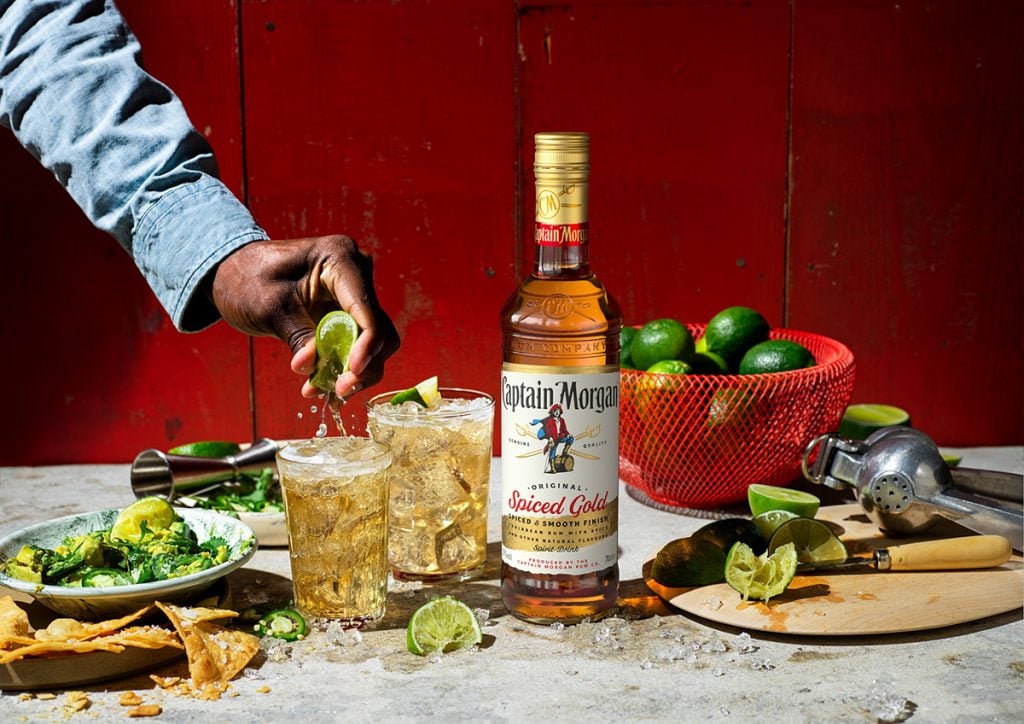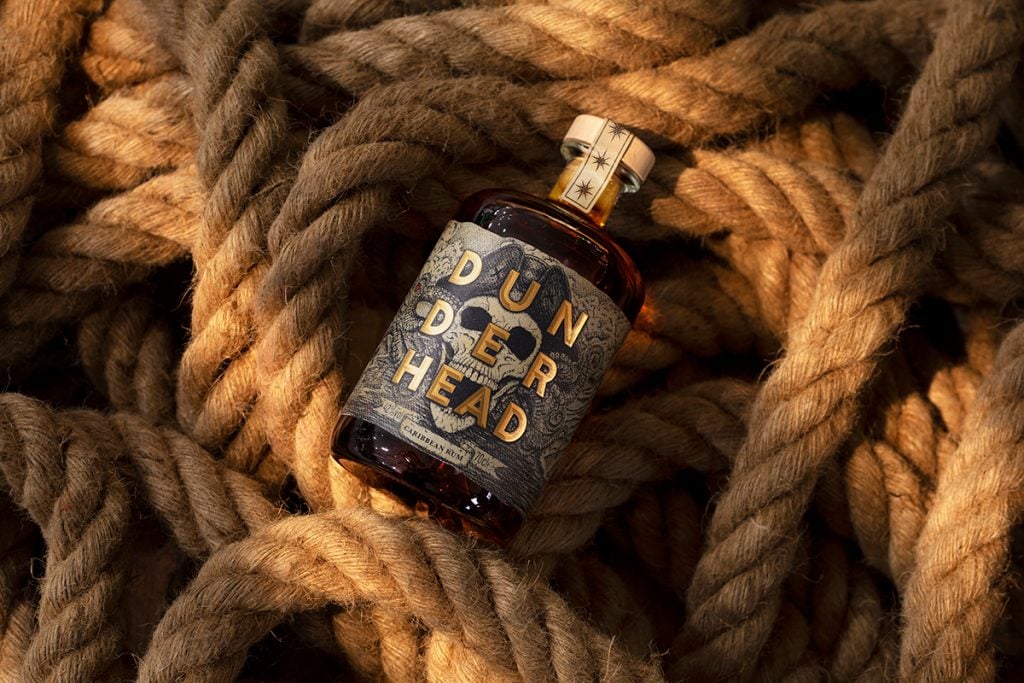Fifteen men on the dead man’s chest-
Yo-ho-ho, and a bottle of rum!
Drink and the devil had done for the rest-
Yo-ho-ho, and a bottle of rum!
You surely know these lyrics from Dead Man’s Chest, a song from Robert Louis Stevenson’s classic Treasure Island (1882), the ultimate pirate tale.
There are so many things associated with pirates – eye patches, wooden legs, treasure chests, ‘X’ marks the spot, the Jolly Rodger, parrots, saying “Arrr” in a vaguely Somerset accent, Johnny Depp – but what interests us most is the enduring association between rum and pirates. From novels, fairy tales, movies… Jack Sparrow to Calico Jack and Captain Hook… when people think of rum, one of the first things they think of is pirates.
Just look at all the rums that have a direct pirate inspiration, including Captain Morgan, Pirate’s Grog, Sunset Captain Bligh, Barti Spiced, Pyrat, Crusty Juggler, Kraken, and Flying Dutchman, while there are also many with naval/nautical connections such as Admiral Rodney, Depth Charge, Admiral Vernon, Pusser’s, Rumbullion!, Black Tot, HMS Victory Navy Strength, English Harbour, Skipper, and Gosling’s Black Seal.
But why do we associate rum of all drinks with sailors and pirates? To answer that question, we need to go back to the 17th and 18th centuries and dive into some maritime history and the socio-economic circumstances of the time.

You know Captain Morgan, of course
Captain Morgan and other drinks
The first big reveal of the day: pirates didn’t exclusively drink rum. In fact, in the early age of privacy, brandy and wine would have been more common. While we have images of swashbuckling scoundrels swigging from a bottle of rum, it wasn’t much of a feature during the 1600s, only becoming a favourite during the first half of the 1700s.
Let’s take the example of a man who directly inspired a modern rum brand: Captain Henry Morgan. A Welshman, he arrived in Barbados likely as an indentured servant and escaped to the English Fleet. Under the command of Vice-Admiral William Penn and with General Robert Venable, in late January 1655, he was part of an unsuccessful attack on the Spanish island of Hispaniola, present-day Santo Domingo. To bring some good news home to Oliver Cromwell back in blighty, Penn set his sights on what was, at the time, a poor and virtually undefended island under Spanish rule called Jamaica. Penn and Venable were sent to the Tower for their failings regardless, but Morgan thrived in Jamaica as a privateer – pirates acting under the cover and with the support of a state – in the Caribbean.
He was a scourge of Spanish ships, notoriously cruel but powerful, rich, and popular among fellow pirates. He was eventually rewarded with important positions and a knighthood by the English Crown. But in all this pillaging and plunder, he wouldn’t have sunk much rum. In And a Bottle of Rum: A History of the New World in Ten Cocktails (2006), W. Curtis reveals that much of Morgan’s exploits were recorded by a remarkable account published by Dutchman Alexander Exquemelin, but says “The detail in Exquemelin’s book is so rich and so lavish that it grieves me slightly to make one observation. At no time is rum ever mentioned.”
Morgan’s target was Spanish ships and, thanks to lobbying in Spain by wine and brandy producers, the production and sale of cheap colonial rum was not encouraged by the Spanish. So it was wine and brandy, not rum, that Morgan would likely have enjoyed. When Bartholomew Roberts (known initially as The Great Pyrate and eventually as Black Bart or Barti Ddu in Welsh) took several vessels circa 1720, records show they found the cargo of liquor to be “so plentiful, it was estimated a crime against Providence not to be constantly drunk.” No mention of rum, however.
Not that there’s much reason to expect any pirates at the time to be particularly fussy about the type of alcohol they consumed. When you’re out at sea in the 17th century, you do rather take what you can get. “I’m more of a merlot man” is not the kind of thing you’d hear on The Flying Dutchman
Pirates of the Caribbean
That would change, however. As you might have already gathered from this article or from The Pirates Of The Caribbean film series and ride, the Caribbean was a prime region for pirate activity, particularly during what is known as the Golden Age of Piracy (1650s-1730s). The reason is fairly simple, this was where the maritime trade routes connecting Europe, Africa, and the Americas met, which meant there was a lot of valuable cargo. Car thieves operate in car parks for a reason. Gold, silver, spices, and other goods were ready to plunder, with numerous islands and hidden coves providing ideal hideouts for pirates to evade capture and resupply their ships. European colonial powers vied for control of the region, creating a fragmented and chaotic environment which pirates exploited.
These islands, being major centres for sugar cane cultivation, naturally became hubs for rum production. Rum is made from sugar, don’t you know, specifically sugar cane juice, sugar cane honey, or molasses, a byproduct of sugar processing. As the European powers established and expanded their colonies in the Caribbean in the 17th and 18th centuries, they increasingly encouraged local rum production. The importance of sugarcane in the colonial slave trade would eventually make it the spirit of the Caribbean. By the early 1700s, rum had spread everywhere in the Americas and it was more than a drink, but a valuable commodity that could be used for trade and loot. One that would have been transported by ship from island to island and beyond. So when pirates raided these ships, it was rum they would plunder.
Location, location, location. If pirates and sailors frequented the North Sea and the Atlantic Ocean more, we might associate them with whisky.
Blackbeard’s love of rum
We can see how popular rum was with pirates of the early 18th century from records about the infamous Blackbeard. A former privateer during the Spanish Succession War (1701-1714), he was a pirate with a legendary passion for rum. Blackbeard was said to consume an inadvisable cocktail of rum and gunpowder that he would ignite and swill while it flamed. But according to biographer Robert Lee, “Rum was never His Master. He could handle it as no other man of his day, and he was never known to pass out from an excess”.
Blackbeard’s contemporaries report that he and his crew lived perpetually almost in a state of drunkenness, but it would appear this did not inhibit them. In fact, their exploits were partly inspired by the lack of rum. In Blackbeard’s ship’s log, he wrote, “Such a day, rum all out: – Our company somewhat sober: – A damned confusion among us!” This was resolved after they sacked a ship carrying “a great deal of liquor on board, I kept the company hot, damned hot; then all things went well again.” It’s stories like these, greater written into legend by books like Treasure Island, that helped mythologise the association between rum and pirates.
The British Royal Navy
Rum’s value as a currency isn’t exemplified best by pirates, however, but by the British Royal Navy. It officially introduced rum as a daily ration through a regulation passed in 1731. This “rum ration” or “tot” was a daily allowance of rum given to sailors, favoured because of rum’s durability compared to water and beer, which could develop algae or go stale respectively on long voyages. Rum was particularly suitable for extended periods at sea as the high alcohol content inhibited the growth of bacteria and mould, which were common problems in other stored liquids on ships. It also raised morale, so long as it was kept in good supply.
Every sailor was given a pint (roughly a modern American pint, 473ml), a ration typically mixed with water to produce “grog,” which helped to prevent the overconsumption of alcohol while maintaining morale and hydration. In 1740, Admiral Vernon concocted a drink of one part rum mixed with four parts water, lemon juice and brown sugar. Essentially an early DIY Daiquiri, with an anti-scurvy side effect. The ritual of the rum ration became a deeply ingrained part of naval tradition, continuing until as late as 1970, when it stopped on 31 July known as Black Tot Day. A sombre day indeed.

Sip it, mix it, you can’t really go wrong here
Drink like a pirate
As a staple on naval and pirate ships, rum became a significant part of maritime culture. One that has had an enduring legacy worth toasting to. If you want to give a big Yo-ho-ho, and a bottle of rum! while drinking like a pirate then we recommend these delicious rums:
Sunset Captain Bligh XO Rum 70cl
Sweet, rich, and tasty XO rum from Saint Vincent and the Grenadines, this serial award-winner has an authentic, retro feel thanks to its beautiful nautical label. We can absolutely imagine a pirate swigging from a bottle of this.
Dunderhead Rum 70cl
Another gorgeous label, this time with a much more direct pirate theme, is on the bottle of Dunderhead Rum. A blend of Caribbean rums, including a high-ester Jamaican rum, gives this value-for-money spirit a funky, fresh, and fruity flavour. Pirates love a good steal…
Flying Dutchman Rum 4 Year Old – Batch 2 (That Boutique-y Rum Company) 50cl
A Dutch rum named after one of the most famous pirate ships of all time is ticking a lot of boxes for me. Just imagine looting this beauty from a Dutch ship and then taking a swig on a beach. God, pirates are cool.
What kind of rum did Jack Sparrow drink?
What we can’t recommend is that exact rum that Jack Sparrow, the iconic character from the Pirates of the Caribbean series, drinks. The exact type is never specified in the films. Given the historical context and the character’s Caribbean adventures, you could reasonably speculate it was dark or spiced rum, which were prevalent in the region then. Although, if you’ve seen the films, you’ll know that really he would have drank whatever rum he could get his hands on. One of the more historically accurate aspects of the films…
